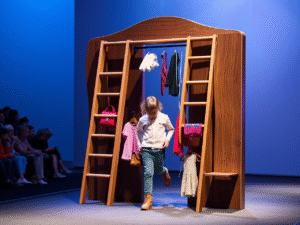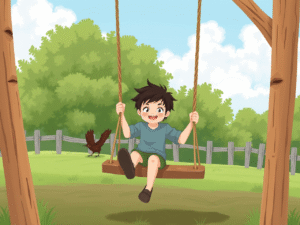
The Allure of the Swing
Swinging is an activity that resonates with people of all ages, encapsulating a unique blend of joy, freedom, and nostalgia. The timeless appeal of the swing set draws children, teenagers, and even adults to embrace its gentle sway, evoking feelings of exhilaration and delight. As one takes flight through the air, the body experiences a burst of energy accompanied by a sense of weightlessness that is both thrilling and liberating. This simple yet profound act of swinging ignites a connection to our inner child, where pure joy reigns supreme.
The sensory experience of swinging is undeniably captivating. As one rises higher, the wind whistles past, creating a soothing sound that accompanies each rise and fall. The sensation of height brings an adrenaline rush, igniting excitement as one gazes down upon the ground below, blurring the lines between gravity and freedom. Each swing presents an opportunity to soar into a state of pure bliss; it is a mini-adventure that requires nothing more than a simple piece of playground equipment. This ability to escape mundane realities, even if just for a moment, contributes to the allure of the swing.
Nostalgia further enhances the experience of swinging, as many individuals associate it with cherished memories from their childhood. Pictures of carefree days spent at the park, giggling with friends, and challenging one another to see who could swing the highest often come flooding back during a swing session. This connection to the past not only reinforces one’s emotional relationship with the activity but also fosters social interactions, reminding us of simpler times spent outdoors. The swing set ultimately represents more than just a playground fixture; it embodies the joyful essence of youth, making it an irresistible and cherished pastime for many.
A Brief History of Swings
The history of swings is deeply rooted in human civilization, with evidence suggesting that swings have been a part of play for thousands of years. The earliest mention of swings appears in ancient Greek art, where children are depicted playing on simple hanging seats made from ropes or vines, suspended from trees. These early swings were crafted using natural materials, demonstrating the ingenuity of ancient cultures in creating tools for recreation.
Moving through time, swings became more sophisticated. The Romans, known for their contributions to architecture and engineering, also embraced the concept of swinging. They introduced innovations such as wooden frames and more durable materials, allowing swings to be more accessible to the general populace. The popularity of swings continued to spread, with variations appearing across different cultures, from the simple wooden swing sets in rural villages to elaborately designed swings in royal gardens.
The Industrial Revolution brought about significant changes in the materials used for swings. By the 19th century, metal and other persistent materials began to be incorporated into swing design, resulting in durability advancements that expanded their usage in playgrounds. Swing sets, as we know them today, became a common feature in public parks and schools, emerging as a symbol of childhood joy and freedom. These modern swings are engineered for safety and accessibility, catering to a wider range of abilities.
Today, swings remain a beloved element of play across the globe, with recreational facilities constantly evolving to include artistic and inclusive designs. From traditional swings to those that promote interaction and collective play, the legacy of swings reflects our enduring desire for joy and connection through simple yet profound activities. The historical evolution of swings not only showcases their popularity but also emphasizes their value as timeless apparatus in children’s play and development.
The Mechanics of Swinging: How It Works
Understanding the mechanics of swinging necessitates an examination of the physical forces at play, which include gravity, momentum, and centrifugal force. The experience of swinging is fundamentally influenced by these forces, which together contribute to the motion we enjoy when seated on a swing set.
When a person sits on a swing, they are initially at rest. Upon being pushed or released from a stationary position, gravity sets the stage for movement. Gravity exerts a pulling force downward on the swing and its occupant. As the swing moves away from its starting point and reaches an apex, gravitational force works to decelerate the swing due to its downward pull. As the swing reaches the highest point of its trajectory, the kinetic energy achieved through momentum transitions into potential energy.
Momentum plays a crucial role in swinging higher. When the swing is pushed, it gains speed, increasing its kinetic energy. The swing’s maximum height occurs when the kinetic energy is transformed into potential energy, and at this point, the swing momentarily halts before descending again. This back-and-forth motion continues as long as there is an external force applied, be it through a push or by using one’s body weight to lean back and forth.
Centrifugal force also contributes to the swinging experience, creating a sensation of weightlessness during the arc of the swing’s descent. As the swing moves outward, this perceived force acts perpendicularly to the direction of the motion, resulting in a feeling of exhilaration. The combined interaction between these forces explains the dynamic act of swinging, where thrill and enjoyment fuse seamlessly, providing an activity enjoyed by children and adults alike. Each swing, driven by the laws of physics, creates an experience that resonates joy and excitement.
The Physical Benefits of Swinging
Engaging in swinging can provide numerous physical benefits, making it an enjoyable yet effective form of exercise. One of the primary advantages of using a swing set is its ability to enhance balance and coordination. As individuals sway back and forth, their bodies must constantly adjust to maintain stability. This equilibrium training is crucial for developing core strength and improving overall motor skills, especially in children whose bodies are still developing.
In addition to promoting balance, swinging also acts as an excellent full-body workout. When a person swings, they engage various muscle groups, particularly in the legs, core, and arms. The repeated action of pushing off the ground with the legs and pulling with the arms fosters strength and endurance. This dynamic movement can be seen as a fun way to improve cardiovascular fitness, as it elevates the heart rate and encourages circulation throughout the body. Moreover, swinging can be a low-impact alternative to more strenuous exercise routines, making it accessible for individuals of all ages.
The rhythmic motion of swinging is not only physically stimulating but also beneficial for developing spatial awareness. As individuals gain momentum, they learn to navigate their surroundings better, enhancing their spatial and body awareness. This skill is particularly important for children as they build critical foundational movement skills that will serve them throughout their lives. As such, incorporating swinging into playtime or fitness routines can lead to significant improvements in physical health while simultaneously providing enjoyment.
In conclusion, swinging is an engaging activity that offers multiple physical benefits, from enhancing balance and coordination to promoting strength and cardiovascular health. Its ability to serve as an enjoyable form of exercise makes it an ideal choice for fostering an active lifestyle.
Emotional Benefits: Joy and Relaxation
Engaging in the seemingly simple act of swinging can yield profound emotional benefits that extend beyond mere recreation. The rhythmic motion of swinging often evokes feelings of joy, tapping into a sense of carefree bliss that many experience in childhood. This sensation is not simply nostalgic; it serves as a powerful stimulus for happiness, activating endorphins and promoting an overall positive emotional state. The sheer act of letting go while in motion can transport individuals back to simpler times, allowing them to momentarily escape the complexities of adult life.
Moreover, swinging facilitates a unique form of relaxation. The back-and-forth movement engenders a meditative state, enabling individuals to find solace and tranquility in their surroundings. This peaceful rhythm can effectively disrupt racing thoughts and anxiety, providing a calming effect. The gentle breeze against the skin and the harmonious creaking of the swing set can further enhance this experience, creating an ambiance that encourages mindfulness and emotional self-awareness.
The psychological benefits of swinging extend into realms of stress relief and the enhancement of one’s overall emotional well-being. The act of swinging can generate a sense of freedom and empowerment akin to that of flying. It liberates the mind from daily pressures, allowing for moments of introspection and clarity. This freedom often leads to enhanced creativity and problem-solving abilities, underscoring the importance of integrating such activities into one’s lifestyle for emotional balance. The combination of joy and relaxation associated with swinging exemplifies its invaluable role in promoting emotional health, making the swing set not merely a playground fixture, but a significant contributor to holistic well-being.
Swinging through the Ages: A Family Activity
Swinging is a timeless activity that transcends generations, creating cherished moments for families. From toddlers discovering the exhilarating sensation of soaring through the air to adults reliving their childhood experiences, a swing set serves as a bridge connecting family members of all ages. This simple yet profound playground fixture fosters a unique environment for bonding, as parents and grandparents often find themselves engaging with children in joyful play.
When parents push their little ones on the swing, they are not just helping them enjoy a ride; they are actively participating in a shared experience that strengthens their relationship. The laughter of children punctuates the air, while parents witness the enjoyment and delight of their offspring. This dynamic interaction not only promotes physical development but also nurtures emotional connections, making swinging a vital family activity.
Moreover, as children grow, they often invite their friends or even their parents to join them. This inclusion allows for the continuation of delightful moments, where new memories are created, strengthening the family bond. Adults rediscover the pleasure of swinging, as they reminisce about carefree days and share these joyful moments with their children. The swing set thus transforms from a mere playground accessory into a significant vehicle for connection and interaction.
Additionally, family gatherings at parks featuring swing sets allow for diverse generations to engage in shared play. Whether it’s a grandparent imparting wisdom while watching their grandchildren or parents demonstrating how to swing higher, these interactions promote invaluable life lessons, enhancing family ties. As families spend time together on swings, they create lasting memories that will be cherished for years to come, proving that swinging is indeed a remarkable family activity.
Setting Up the Perfect Swinging Experience
To create an optimal swinging experience, selecting the appropriate swing set is crucial. When choosing a swing set, consider the material, design, and features that best suit the needs of your children. Wooden swing sets often provide durability and aesthetic charm, while metal sets are typically easier to maintain and may offer a modern look. Additionally, ensure that the swing set includes multiple swing types—such as infant swings, traditional swings, and gliders—to cater to various age groups and provide inclusive fun for all users.
Equally important are the safety measures you will implement. Before installation, assess the specific location of the swing set. Ensure it is on level ground, away from any structures, trees, or sharp objects that could pose a risk during use. The area beneath and around the swing set should be cushioned with safe materials such as mulch, rubber mats, or sand to reduce injury impact. Regular inspections of the swing set for wear and tear are vital, as they help maintain safety and efficiency. Be sure to check the hardware, ensuring bolts are tight and intact, while also confirming that swings are securely attached and free from damage.
Creating an inviting swinging environment can enhance the enjoyment of the swing set. Ideally, the swing set should be placed in a shaded area to provide relief from intense sunlight, thereby encouraging longer play sessions. Surrounding the swing set with engaging elements, such as garden decorations or seating for supervising adults, can make the space more appealing. Lastly, consider establishing a regular maintenance routine, which may include cleaning, lubricating moving parts, and checking for rust or rot. By effectively setting up the swing set and prioritizing safety, you can ensure a joyful swinging experience that promotes play, imaginative fun, and community among children.
Fun Games and Activities on the Swing
Swinging offers more than just the joy of soaring through the air; it can also be the foundation for a host of fun games and activities that enhance the swinging experience. One engaging activity is the “Swinging Tag” game, where one player is tasked with tagging others while swinging. Players must navigate their swings skillfully, making the game a delightful mix of physical exertion and strategy as they try to avoid being tagged while maintaining momentum.
Another enjoyable challenge is competitive swinging, where participants strive to swing the highest. This can be done either individually or as a group, with each player taking turns to see who can reach their maximum height. Setting a timer adds an exciting twist; players compete against the clock, urging them to pump their legs harder to gain more height and achieve their personal bests. Such activities not only encourage competition but also foster teamwork when played in groups.
Imaginative play is another fantastic way to enjoy swinging. Children can transform their swings into anything their minds can conjure. A swing can become a pirate ship navigating through the treacherous seas or a rocket ship blasting off into outer space. By incorporating props such as ropes or fabric, children can enhance their immersive experience. This type of imaginative play allows for creativity and can involve storytelling, where each swing becomes part of a grand adventure.
Additionally, swings can be used for various physical challenges. For example, players may take turns performing specific tasks while swinging, such as reaching for a target object or attempting tricks like aerial somersaults while maintaining balance. These fun games and activities position swinging as a versatile platform for engaging play, nurturing both social interactions and physical development in a dynamic setting.
Conclusion: Embrace the Swinging Lifestyle
As the essence of childhood nostalgia intertwines with the experiences of adulthood, swinging emerges as a simple yet profound source of joy and connection. The act of swinging transcends age barriers, inviting individuals of all generations to engage in a timeless activity that fosters both fun and excitement. Whether it is a parent pushing a child on a swing or friends enjoying a moment of carefree laughter, the swing set becomes a focal point of cherished memories and shared happiness.
Rediscovering the thrill of swinging is about more than just physical movement; it encompasses the revival of childhood wonder. The rhythmic motion of rising and falling in the air invokes feelings of freedom and exhilaration, reminding us of simpler times when joy was found in the basic act of swinging. This seemingly mundane activity allows individuals to momentarily escape the complexities of everyday life, offering a chance to reconnect with oneself and those around them.
The magic of swinging lies in its ability to create connections, whether through social interactions at playgrounds or shared moments in one’s backyard. Such experiences contribute to a sense of community and belonging, enriching lives through camaraderie and mutual enjoyment. Swinging could even be seen as a form of play that nurtures critical emotional bonds, allowing individuals to cultivate relationships while experiencing pure delight.
In every swing, there exists an invitation to unleash happiness and rediscover the joy that life offers. Thus, embracing the swinging lifestyle invites everyone to step outside, embrace the moment, and share in the exhilarating laughter that accompanies this timeless activity. So, take a swing and let the jubilant adventure begin, as the enjoyment of swinging continues to thrive across generations.






